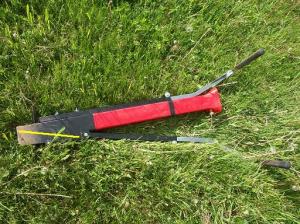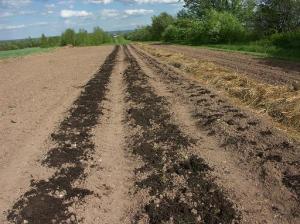In the Spring we start a lot of seedling in soil blocks made using a soil blocker from Ladbrooks in the UK. I’ve found that in many cases there is less transplant shock than transplanting from cells plus using transplants instead of direct seeding gives us a headstart on the growing season and and jump on the weeds.
For the last two years we have transplanted by making holes with an E-Z digger and then dropping in the soil blocks. This involves either dragging the trays of seedlings (and ourselves) along the ground in a stooped over position OR requires the dropping of the soil blocks from a great height. In the first instance I always ended up with a really painful back, in the second many of the blocks did not ‘take’ very well and had to be replanted later.
This year is the year of the Hatfield Transplanter a tool that allows you to plant from a standing position and ensures that the seedlings are buried sufficiently deeply.
That’s the theory anyway, so how did it work out?

Hatfield Transplanter
The Hatfield transplanter works as follows.
You pull the handles apart to close the end of the planting shaft (if you don’t do this it just fills up with soil) then shove it into the ground. This is easy enough provided you remember to pull the handles before planting and it’s surprising how quickly you forget!
Open a hole in the ground by bringing the handles together.
Then you take a seedling and drop it down the shaft. This is the tricky bit. We do have the right sized shaft (they come in different sizes) as in some cases the block only just fits down it, but in many cases the block twists on its way down. To my way of thinking if we were planting seedlings in longer thinner cells this would not happen and the reason that the soil blocks are able to twist is because they are short and stubby. I also wonder if we were planting something with a larger more sturdy leafy part that that might also prevent flipping.
We did indeed get to plant from a standing position, but there was an awful lot of bending over to correct blocks that had twisted on the way down the shaft and had been planted sideways with the leaves buried.
In the first bed we planted first with the idea that we would ensure that the plants were buried well by top-dressing with compost afterwards. This proved to be time consuming and back murdering so for the second bed we applied the compost first and planted through it.
By the time we got to the third bed we were both getting tired and grumpy. This is a two man task as one person has to handle the Hatfield Transplanter and the other has to hold the tray of seedlings and drop them down the shaft. Using the transplanter is light work, but lugging a tray of watered seedlings around (we pre-water them so they don’t run out of water in the field in the first few days) on one arm gets pretty tiring particularly as the planting process is not as swift as we’d hoped. Also, constantly having to bend down to correct the soil blocks was pretty discouraging.
Also, while it maybe possible that the transplanter will cut through plastic mulch, even with the end well sharpened it did not cut through straw mulch which was a disappointment as it means applying the mulch afterwards which is a lot more time consuming.
So we ended up planting the third bed the old-fashioned way using the E-Z diggers and dragging the tray and ourselves along the ground. It was harder on the back but it was actually quicker and more accurate than using the Hatfield Transplanter.
So for anyone thinking of buying a Hatfield Transplanter here are my thoughts
- Short stubby soil blocks bad, long thin cells probably better.
- Larger sturdier plant tops probably better (onions twist really easily)
- Wider spaced transplants better (its not too bad dragging yourself along with a tray and an E-Z Digger when you are planting three rows at 6 inch spacing but its not so much fun planting a single row at 2 ft spacing – this is where planting from a standing position is a real bonus)
- Better for tomatoes, peppers, squash? Not so good from onions and cabbages?

Three beds of onions and leeks
Leave a comment